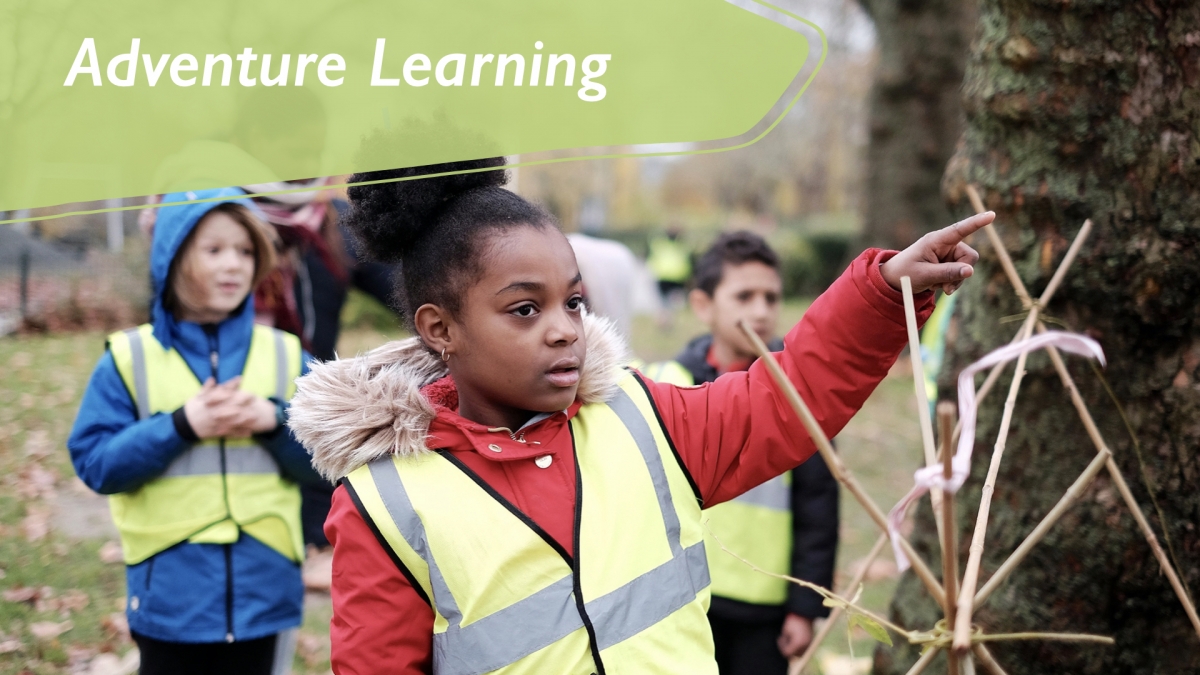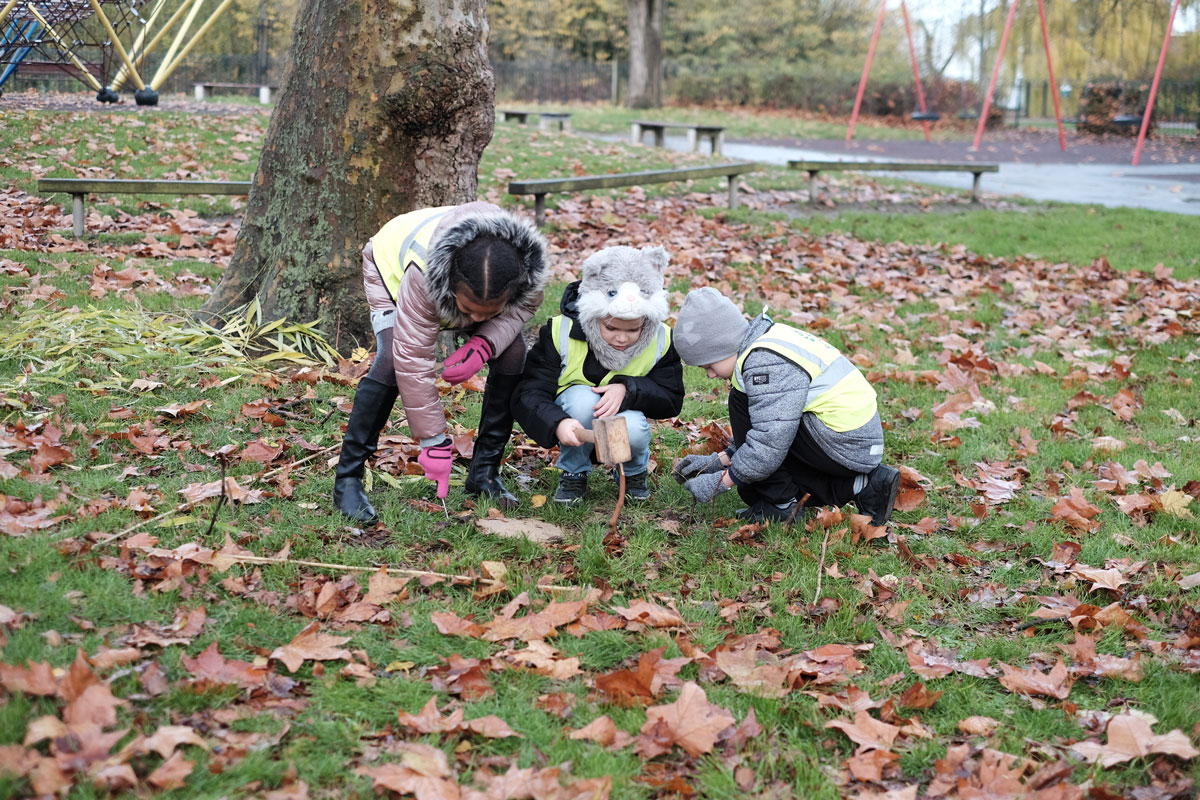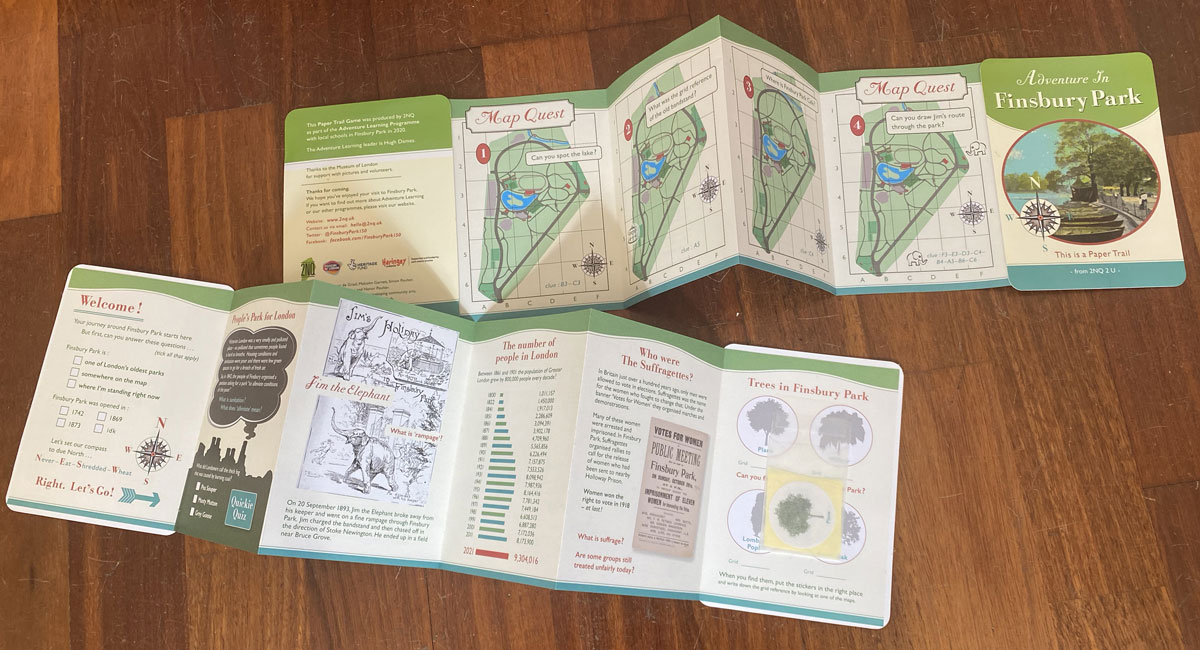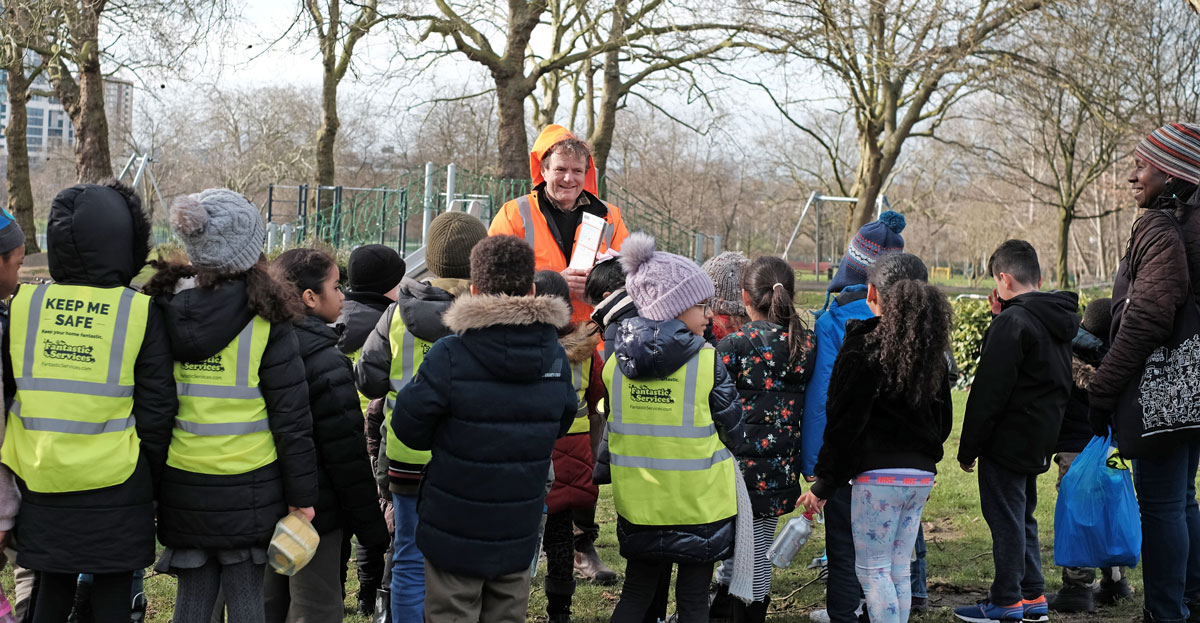
P+H: Adventure learning – report

In 2019-20, 2NQ ran a programme of heritage events and activities called People + Heritage with the communities around Finsbury Park, supported by funding from the National Lottery Heritage Fund and Haringey Council. One of the main programme strands was working with local schools to deliver outdoor adventure learning sessions in the park.
What happened
The People + Heritage Outdoor Adventure Learning Programme comprised a total of 12 half-day outdoor adventure learning sessions with 334 primary school pupils of eight participating schools in the area around Finsbury Park, in the London Boroughs of Haringey, Hackney and Islington. The sessions were led by 2NQ’s Adventure Learning Lead Hugh Dames and they were held in Finsbury Park.
The outdoor sessions were designed to engage the children in the heritage of the park and its natural assets, and to give them an opportunity to reflect on their own relationship with the park. Physical and digital assets, produced in advance and handed out to the children, helped to consolidate and build on the information that was shared and the skills that were imparted during the sessions.
Top take-aways
Outdoor learning engages pupils in ways that are not possible in the school environment and improves soft skills such as teamwork and problem-solving.
Post-COVID, the case for increasing this type of activity, and training teachers in the skills relevant for delivering outdoor learning experiences effectively, is greatly enhanced.
The sessions
The form of the sessions was that groups of schoolchildren and their teachers met with Hugh Dames in Finsbury Park for a half day, before or after lunch to work around the school timings.
The sessions opened with an introduction to reading a compass and then reading maps, using large and small-scale maps of the park and surrounding area which were provided.
Hugh talked through the history of the park, noting on the map where significant events had taken place and highlighting notable features past and present.

The children were then set the task of creating their own physical maps of the park, highlighting sites of historical, and also personal, significance. At the close of the sessions the children were invited to present their maps to the group and talk about the thinking behind them.
The content of these adventure learning sessions is drawn from and linked to the requirements of the school curriculum:
- Geography requires younger years to be able to read two-point grid references, to cover the difference between natural and man-made features in our environments, and further requirements cover map-making and compass work
- Art and design requirements are met by exploring and making with different natural materials
- The History curriculum is supported by learning about the history of the local area
- Relevant requirements for English are met by children presenting their maps as teams in a concise manner
- Soft developmental skills are supported by the teamwork involved in the activities
The sessions support children’s health and wellbeing by carving out time for them to be outside, away from digital screens, and in supporting them to develop and think about how they relate to their local spaces.
Teachers were invited to participate and over the course of the session they took on the role of co-deliverers. The intention behind this was to transfer skills in using the methods and processes of outdoor adventure learning, and specifically to show how they might run similar sessions themselves.
Health and safety instructions were given at the start of each session, including information on how to handle tools and materials safely.
Teachers and schools were responsible for behaviour and for the general safety and wellbeing of the children while on site.
Production and dissemination of materials
We produced and disseminated paper maps and trails to participating schools, building on the information shared in the sessions. This enabled pupils to reflect on the information shared in the session afterwards, and to practise skills they had learned, such as map reading.

Physical copies of the materials were hand-delivered to many of the participating schools.
As a result of the Coronavirus lockdown, we were forced to cancel the sessions booked to take place after mid- March.
Responding to the new constraints and situation, and knowing children would now be at home looking for direction and stimulus, Hugh designed two resource packs for Family Adventure Learning Activities, which were distributed in print to participating schools and made available for schoolchildren and their families online at https://2nq.uk/blog/adventures-age-social-distancing.
The first, for Key Stages 1 and 2, focused on general outside learning, including wildlife identification and making your own compass. The second, for all three stages, focused on growing your own vegetables. This was designed for those with as well as without gardens or balconies. It could be done with things found around the house and did not require special materials to be purchased.

Adventure in Finsbury Park – a ‘Paper Trail’ game produced by the 2NQ team for use by session attendees and free distribution through local outlets.

One of the activities in the Paper Trail was to identify these trees and place the stickers in the book, marking the location grid reference using the maps of the park.
Recruitment and selection of participants
In terms of selection, we decided to focus on primary schools.
We wanted to work with children who live close to the park and could go there on foot. We wanted to work with schools in each of the three boroughs of Haringey, Hackney and Islington, for whom the park is a significant and unifying space and asset. We wanted to ensure we worked with a range of ages, and with children with mixed and additional needs.
We invited participating schools to give us formative feedback on the proposed session structure, which was agreed with them after taking their feedback into account and reshaping the structure accordingly.
We approached and received the active support of the Director of Education at Haringey Council, who promoted the offer to all primary schools in the borough.
Outputs
- We developed a programme of custom-designed adventure learning sessions for Finsbury Park, focused on engaging pupils with the heritage of the site while offering opportunities to acquire new skills and knowledge relevant to the school curriculum.
- We developed the programme in collaboration with, and in response to feedback received from local partners.
- We conducted outreach to identify schools across the three boroughs to participate in the programme, successfully securing eight, including schools who cater specifically for children with additional needs.
- We delivered 12 half-day sessions with 334 participating schoolchildren from six schools in Haringey, one in Hackney and one in Islington.
- We produced online and printed learning resources sent to all participating schools during lockdown, with activities focused on outside learning, and outside/inside growing. These were designed to be accessible to all income brackets and living arrangements with no special materials required.
- We supported teachers to co-deliver sessions in situ, delegating responsibilities to them.
- We produced and disseminated paper maps and trails which brought together the information that had been shared in the course of the session.
- We produced and distributed a ‘Paper Trail’ adventure learning game.
Project outcomes
1. Skills development
Pupils’ skills were enhanced by:
- The map-making exercise – practical making skills.
- Reflecting on their experiences of the park.
- Developing greater awareness of different navigational tools: compasses and maps.
- Practising verbal articulation skills and teamwork.
2. Teacher benefits
Teachers benefited by:
- Growing confidence and skills in teaching in non-classroom environments and leading more practical, hands-on sessions.
- Using teacher-modelled ways of engaging pupils in local history, as part of an active, creative and hands-on activity.
3. Wellbeing
Pupils’ wellbeing was supported by:
- Having the opportunity to be outside, to play, discover and make, without digital screens.
- Connecting to the natural landscape, both in a tactile sense by making with natural found objects, and also through the story of the place.
- Modelling an enjoyable out-of-school activity for friends to partake in.
Evaluation
Evaluation forms were sent to all participating schools, to be filled out by staff who participated in the sessions. All participating schools responded.
We asked questions about the quality of the service and the experience delivered, and about the achievement of ‘Learning Outcomes’, i.e. the impacts on the children who took part. We also asked what we can improve and how respondents would summarise the experience.
What was the quality of the service and the experience?
We asked participants to rate each question using scores as follows: 1 Outstanding, 2 Good, 3 Requires Improvement, 4 Inadequate. They were also invited to elaborate with comments.
The ratings given for all questions in the quality section were either Outstanding or Good, with highest scores for the quality of prior information, achieving objectives, value for money and overall satisfaction:
Comments
Most comments were very positive, including:
Excellent, Good overall, Very helpful.
Highlighted as a particular success was:
“The range of resources made available as part of the session.”
Opportunities for improvement were:
“To have more maps on hand.”
“Closer management (of) the use of tools used throughout the session.”
Reflections
Whilst the teachers and schools were in charge of the behaviour and conduct of the children, and health and safety instructions were given at the start of session, further measures could be put in place, such as sending the instructions in advance for teachers to read out to students before the visit.
We had limited numbers of maps available, so it made sense to look at them as a group, rather than break into smaller groups. In future, we will look at having more maps on hand, so that the assisting teacher could bring them out if it was felt necessary – for example, if a child was failing to engage as part of the group.
Did we achieve Learning Outcomes?
We asked the schools to indicate whether they felt a range of learning outcomes had been achieved by scoring 1 for Strongly Agree, 2 Agree, 3 Disagree and 4 Strongly Disagree.
They were also invited to elaborate with comments.
In this section, all agreed or strongly agreed that four out of the five outcomes had been achieved, and only one respondent felt that pupils’ resilience and determination had not been improved by the session. 84% strongly agreed that the session had engaged the children in learning in a way that is not possible in the normal school environment.
Comments
Areas identified as successful in the comments included:
High levels of participation and engagement shown amongst all children:
“Children enjoyed the trip great to get out in the open. All children participated and thoroughly enjoyed the session.”
Allowing for opportunities for different pupils to shine, and for new working dynamics to emerge:
“I was surprised to see a quiet child in my class be very vocal and leading his group.”
“Children were communicating and working as a team. They were all involved and no one taking a backseat, which you sometimes find in classroom activities.”
Collaboration between children and an opportunity for them to practice and develop communication skills in a new environment:
“Collaborating in teams. Overcoming obstacles such as making mistakes.”
“Explaining their ideas to peers.”
“Sharing their ideas with their peers.”
The value of outdoor learning, offering a new space that allowed for different types of teaching, learning and interacting); one that simultaneously was a familiar space for pupils to reflect on:
“Some of our pupils love being in different learning environments.”
“Nice reflection on personal memories that the park has.”
“Opportunity for outdoor learning.”
“Children all able to move and talk at the same time. Constraints of the classroom does not provide this.”
A weakness identified in the comments concerned the capacity of the project for ‘Improving their resilience and determination’:
“This usually needs a longer-term project”
What would have improved your session?
This was an open question inviting comments:
“We are very grateful to have been able to participate in this project. If it could be a possibility – some pre-sessions with the pupils would allow for relationships to develop, which in turn would maximise engagement.”
“More maps for children to look at. Warmer weather!”
“More time for an indoor teaching session.”
How would you summarise your experience in one sentence?
“An excellent opportunity to take the students outside their comfort zone and explore new ways of increasing personal wellbeing.”
“Creative, instructive and active day of learning outdoors.”
“A really hands on session with lots of interesting activities which kept.”
“Hands-on outdoor, fun and exciting learning activities.children engaged.”
“Truly a wonderful morning, lots of smiles, creativity, learning and happiness. Thank you!"

Analysis of the results
1. Assumptions that were proved right
Outside learning offers an opportunity for different students to excel, and for new working dynamics to emerge.
- In the evaluation teachers pointed to this being due to being outside and in nature, freed from the constraints of the classroom, and being taken out of ‘comfort zones’.
- The dynamic range of activities offered were repeatedly cited as being a positive feature to the session, and specifically the ‘hands-on’ and ‘creative’ nature of activities - which allowed for different students to participate in different ways (tapping into different senses).
- It was noted that students who are normally quiet can become more vocal and proactive in this environment, and that on the whole, the majority of the class was engaged, rather than some taking a ‘back seat’ as you might otherwise see.
Outside learning gives opportunity for literacy skills to develop, as well as soft skills such as communication and teamwork.
- It was noted that the session offered ample opportunities for pupils to practise and develop their verbal articulation skill, both in explaining their ideas to team members in the practical exercise, and at the end when they were asked to present.
The session gave pupils the opportunity to reflect on and talk about their experiences in the park, recognising it as a personal and shared local site of significance.
- Students enjoyed being able to share memories of the park, such as feeding the ducks at a young age.
2. Lessons learned
Steps are needed to level the bar in advance of the session, with regard to different children’s degree of understanding.
- It was noticeable that children with previous outside learning experience adapted more quickly to the session, while for those with none it was a lot to take in during a one-off session.
- In future we would look at sending information sheets to teachers to run through with the pupils in advance. This could cover questions such as what a compass is and how to use it, so they’ve had some exposure to the idea before the session.
Limitations of single session.
- Many teachers pointed to wanting more. Where funding is available it would be beneficial to extend these sessions with groups into a series. However, as the feedback shows, it functions very effectively as a one-off event.
Clarity about responsibilities.
- While teachers were clearly told, both before and during the sessions, that they were responsible for behaviour and wellbeing of pupils throughout, this could be repeated again to ensure it is fully understood.
